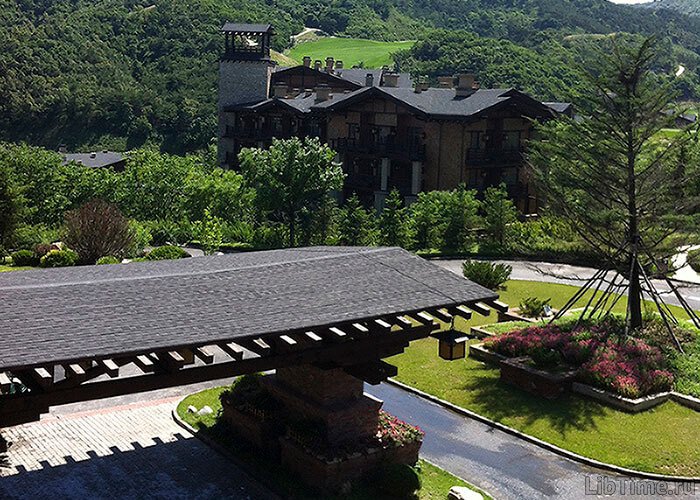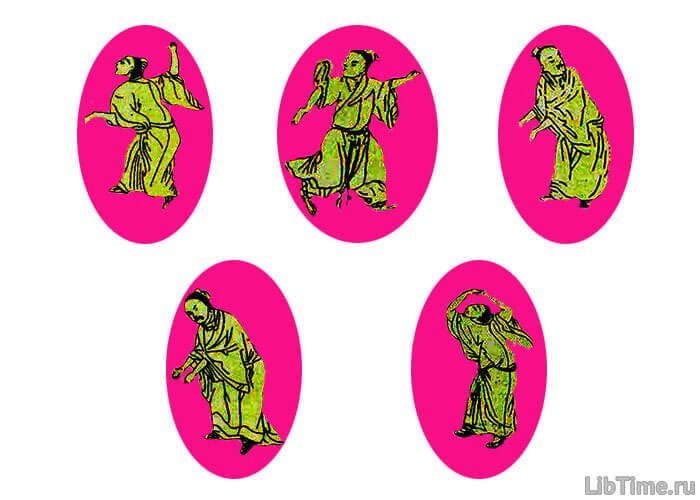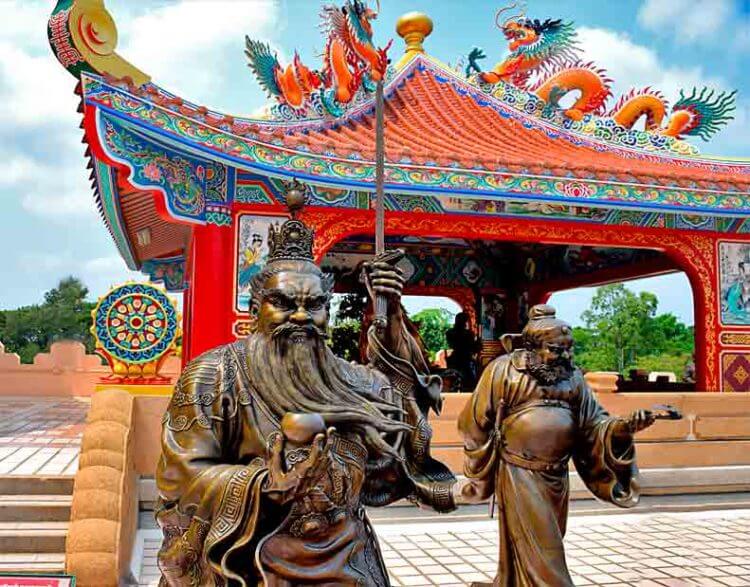Chinese medicine books
The powerful feudal state of China in the 7th century had not only the strongest political and cultural influence on neighboring countries, but also on the development of science and the development of Chinese medicine within the country. Books of Chinese medicine reflect the accumulated experience and knowledge in pharmacology and summarize effective treatment methods. 
China in the 7th century
After the thirteen-year rule of the Sui Dynasty (whose representatives managed, however, in such a short time to put an end to feuds and unite the whole country in 589, as well as to build the "Great Canal" connecting the rivers Baihe, Huanghe and Yangtzejiang with the Hangzhouwan Bay, and to establish relations with Japan and Siam) in China in the 7th century began theso-called Tang-Sun period, which lasted more than six centuries.
Tang-Sun period
During this time Japan borrowed writing, literature, philosophy, ethics and social institutions from China. Japan borrowed almost entirely from Chinese law the so-called Tang reform, which formalized feudal relations in that country.
And Chinese medicine, whose penetration into the islands had begun long before, in the Tang era, became a subject of particularly wide borrowing and imitation for Japanese physicians. Only thanks to the influence of Chinese science did Japanese medicine free itself from the shackles of witchcraft in the 7th century.
China's ties with India
At that time, China's ties with India, on which the decisive political influence was exerted by Chinese commanders who made a victorious march along the Ganges. It came to the point that in 648 the ambassador Wang Yuan-tse overthrew the Indian king and took him with him to China.
Indian medicine, too, was greatly influenced by Chinese medicine; the best books of Chinese medicine were translated into the languages of the peoples of India. From 671 to 695, the famous Chinese physician Yi Jing lived in India and brought to Indian soil many of the achievements of Chinese physicians, including the latest information on pharmacology and methods of pulse examination.
The latter, around the same time, was also adopted by the Arabs. It was not only along the Great Silk Road that Chinese merchants traveled to Central Asia and the Middle East. Chinese shipbuilding, which reached a significant development in the Tang era, provided thecountry withperfect ships for that time, which alone could cross the Indian Ocean and the turbulent Persian Gulf.
and the turbulent Persian Gulf, and they were the only ships to carry Arabian goods going east,
- the chronicles say. Maritime trade, of course, greatly enhanced the exchange of goods.
Tang Dynasty
The Tang Dynasty (618 - 906) came to power as a result of a powerful popular uprising that erupted in 610. Led by the peasant Dou Jian-dae, it had a distinctly anti-feudal character. But, as in many other cases, it was the feudal lords who took advantage of the mass movement: the Shanxi ruler Li Yuan declared himself emperor.
However, Li Yuan and his successors could not rely on military force alone. In order to retain the throne, they were forced to partially alleviate the situation of the peasants: reduce taxes, reduce the terms of the state barstry.
Significant changes occurred in the system of state administration. In the middle of the 7th century, the formation of feudal bureaucratic apparatus based on a hierarchy of ranks, which corresponded to the size of land plots was completed.
To occupy any position, unlike in previous times, one had to pass state examinations and only then to qualify for a post, according to the degree awarded. The country, which by that time stretched from the Yellow Sea to the Aral Sea, from Mongolia to Indo-China, was governed by 3 chambers, 6 departments and many offices, the activity of which was checked by a special chamber of inspectors.
Chinese medicine
Having the most diverse theories and very effective methods of treatment, Chinese medicine was ahead of the then medicine of the Arab East in a number of issues. This is especially true of "pulse diagnosis". The great Avicenna, with his description of 48 "types of pulse", owes much to his acquaintance with the books of Chinese medicine (for more information: Pulse and Heart).
But it should not be presented as if Chinese medicine alone dominated during this period; no matter how high the level of its development was, it always sought to adopt the experience of other peoples.
And having been enriched with some achievements, for example, of Indian, Arabic and Greek medicine (it is known that in the 8th century in China visited quite a lot of Greek doctors), it, having improved the methods of treatment and expanded the arsenal of medicines, reached in the 7-10 centuries even more significant flourishing.
Chinese pharmacopoeia
Further development of pharmacology in China is associated with the name of Tao Hong-tszin. He was born in 452 and died in 536. He revised the first Chinese pharmacopoeia - "Shennong Bian Tsue Jin", written in the 2nd century B.C. - according to his experience.
Tao Hong-jing corrected the description of these medicines in accordance with the experience accumulated during almost four subsequent centuries and added more information about new 365 types of medicines. Thus, the result was a book with detailed descriptions of 730 kinds of medicines, consisting of seven volumes. This work on medicines, entitled "Ming and bei lu", has served as the basic teaching material for folk medicine practitioners for several centuries.
In addition, Tao Hong-ching wrote five volumes of so-called "Effective Prescriptions" and three volumes of "Supplementary Prescriptions," which were also board books for folk medicine practitioners.
Along with the book "Tai ping gien huai fang", which was worked on for thirteen years by the modest physician Wang Hui-yin, who collected in it 16 thousand recipes known at that time among the people, the book of Tao Hong-jing "Ming and bei lu" up to the present time is one of the most valuable manuals for Chinese physicians.
Tao Hong-jing is also known in history as a physician who was one of the first to base his works on the doctrine of four substances (earth, water, wind and fire), each of which can supposedly cause 101 diseases. This doctrine was reflected in his book "Zhou hua bai and fang" (404 prescriptions), which also described many new medicines that came to China from India, and some of the methods of treatment used by Indian physicians.
Many circumstances led to the fact that the above-mentioned book of Chinese medicine "Shennong Bian Que jin" by this time was already largely inadequate to the level of pharmacological knowledge. This book had to be supplemented, first of all, with descriptions of new remedies, for example, those borrowed from Indian medicine.
In addition, during the four centuries that followed its publication, a number of similar works appeared, the title of which almost invariably contains the proper name of Bian Que, which soon became a nominal name for works on pharmacology. "Xin Bian Que" was named by the authors and the book published in 659.
It was compiled by 22 major specialists appointed by the government to supplement, systematize and unify the pharmacological literature available at that time, as well as to make the necessary corrections. Their work is the world's first state pharmacopoeia.
Though Sun Sy-miao may not have been directly involved in the compilation of the said book, but his major work "Chen ji fang" was undoubtedly utilized in doing so. In his "Collection of valuable recipes" he described in detail the methods of application in a number of diseases of such effective remedies as mercury ointment, ephedrine (for asthma), etc. He also wrote "Collection of valuable recipes".
His pen also belongs to the "Collection of additional recipes ("Chen jip and fang"). But Sun Sy-miao was not only a pharmacologist: he left an excellent for his time description of the clinic and treatment of "beri-beri" and "chicken blindness".
The number of medicines used by Chinese medicine in the 7th century increased so rapidly that by the end of this century Chinese medical literature was enriched with almost 30 books (in addition to "Shin Bian Tsue"). And just 36 years later, the best pharmacologists were ordered to edit the relevant literature again.
As a result of the work of 22 specialists led by Li Di in 695 came out "Revised compendium of wood and plant medicines" ("Xin xu Bian Que"), which included a description of 844 types of various remedies. Progress in many branches of knowledge, particularly in pharmacology, was promoted by the fact that in 610 AD, Chinese medicine was enriched with the doctrine of etiology of diseases.
The previously available scattered data on this issue were collected and significantly supplemented by Chao Yuan-fan, whose 50-volume work is valuable primarily because it is essentially the first time that infectious diseases were singled out as a special group and considered in detail.
Naming 67 main causes of various diseases, Chao Yuan-fang proceeds, of course, from the volume of knowledge of his time. But this did not prevent his work was recognized as a classic and many centuries later served as the most important practical guide, and a textbook for those studying medicine. An in-depth interest in dietetics is a hallmark of Chinese medicine.
Chinese medicine books on dietetics
A rather slender doctrine about the harm of excesses, especially in food, with a number of practical conclusions about the role of various diets was created as early as in the 3rd century by Wang Shu-he, known mainly for his book about the pulse - "Mei-ting". But the founder of dietetics as a section on the therapeutic value of certain types of food is considered to be Wang To.
It is he in his book "Wai tai mi yao" gave a very reasonable definition of various kinds of diets for the treatment of many diseases, in particular, for carefully described by him dystrophies. To him belongs the honor of discovering the healing properties of iodine-containing plants (such as seaweed) used to treat thyroid disorders.
At the time when Wang To lived and worked, Chinese dietetics was at its height. Gradually, this method of treatment is losing its former importance. The three hundred years called the Tang period was marked by another extremely important event.
Training of physicians
If before the 7th century the training of physicians was conducted exclusively through individual apprenticeship, and medical knowledge was passed on by inheritance from father to son (history even knows cases when, having no male heir of his own, a physician took in a boy to adopt him and pass on his profession), then at the beginning of this century the administration of court medicine had a new important function: educational.
In 624, a higher medical school similar toTai and Shuwas opened under this department. Training here was conducted on five main departments:
- the so-called medical department,
- the acupuncture and moxibustion department,
- the pharmaceutical department,
- the massage department,
- the department of conspiracies.

The medical department trained specialists in internal diseases, diseases of children, diseases of the ear, throat and nose, teeth and oral cavity. Each department employed specialists of different degrees. The highest degree was the doctor's degree, followed by assistants and, finally, doctors of the first, second and third categories.
The staff of the medical department numbered 271 persons, the staff of the pharmaceutical department - 52, and 16 persons were engaged in administrative work. The common subjects for all departments were the teaching of the pulse and the teaching of medicines. As a result of the first educational institution of its kind in the world, it became necessary to write special textbooks.
They were created on the basis of revision and editing and subsequent rewriting of the most valuable 256 books collected for this purpose (the significant development of publishing activity at that time obviously contributed to the fact that so much information about Chinese medicine of the 7th-10th centuries was preserved for history).
The new books of Chinese medicine included drawings to explain the text, such as pictures of internal organs and medicinal plants. As for the period of training, it lasted from 3 to 7 years, followed by very difficult examinations on theory and practice. It should be said that the practical side of things in "Tai and Shu" paid great attention.
Thus, at the separate existing pharmacy department, which was engaged in the training of so-called "medicinal gardeners", training was carried out mainly directly in the nursery, which also served to provide a special "management of plant medicines".
The creation of a department of conspiracies in the ancient institute was most likely caused by the influence of the church dignitaries, primarily Buddhists, whose religion was becoming more and more overtly mystical in nature.
Office of Court Medicine
The administration of court medicine had another function: administrative. Through its representatives at the provincial governors and major feudal lords, it was in charge of the medical care of the imperial court, representatives of the ruling class, bureaucratic apparatus and, to some extent, troops.
Thus, only for the service of one person of the emperor was allocated a group of physicians, consisting of 37 people, and another 130 physicians were assigned to members of his family.
Privately practicing physicians
Workers were forced to use the services of private practitioners who, for the most part, practiced medicine at their own risk, without official guidance or advice.
However, in order to disseminate knowledge among the medical profession, the Directorate publicized the most important and new prescriptions and summaries of their use in a very original way: the prescriptions were written on special boards and even carved on stone slabs, which were displayed in prominent places for public viewing.
Thus, 101 recipes were publicized at first, and in 796 - 586. In the 8th century there were already several governmental hospitals - so-called "houses for the sick", where the poor were placed. In a number of places in the temples for the purpose of isolation of lepers were arranged "houses for terrible people" - a kind of leprosariums.
The first mention of a hospital dates back to 510, when in Linfen County, Xianxi Province, during an outbreak of some contagious disease (there are reasons to assume that it was cholera), which claimed more than two thousand lives, the first "Yi guan" ("houses of treatment") were arranged.
These are some historical data about Chinese medicine and books of Chinese medicine of the Tang epoch - one of the few very favorable periods for the development of science and culture of the country.


